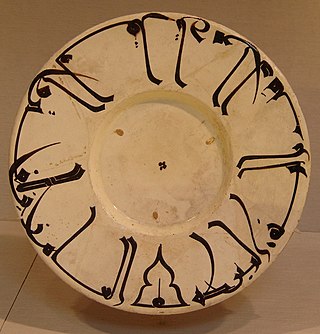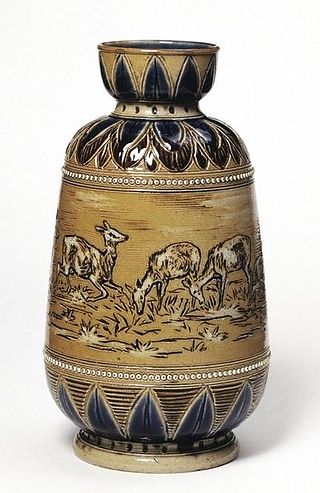
Porcelain is a ceramic material made by heating raw materials, generally including kaolinite, in a kiln to temperatures between 1,200 and 1,400 °C. The greater strength and translucence of porcelain, relative to other types of pottery, arise mainly from vitrification and the formation of the mineral mullite within the body at these high temperatures. End applications include tableware, decorative ware such as figurines, and products in technology and industry such as electrical insulators and laboratory ware.
Oneida Limited is an American manufacturer and seller of tableware and cutlery. Oneida is one of the world's largest designers and sellers of stainless steel and silverplated cutlery and tableware for the consumer and foodservice industries. It is also the largest supplier of dinnerware to the foodservice industry in North America. The company operates in the United States, Canada, Latin America, Europe, and Asia, marketing and distributing tabletop products, which include flatware, dinnerware, crystal stemware, glassware and kitchen tools and gadgets. The factory in upstate NY was sold to Liberty Tabletop, who is the sole manufacturer of US made flatware. The company originated in the late-nineteenth century in the Oneida Community in Oneida, New York.

Earthenware is glazed or unglazed nonvitreous pottery that has normally been fired below 1,200 °C (2,190 °F). Basic earthenware, often called terracotta, absorbs liquids such as water. However, earthenware can be made impervious to liquids by coating it with a ceramic glaze, and is used for the great majority of modern domestic earthenware. The main other important types of pottery are porcelain, bone china, and stoneware, all fired at high enough temperatures to vitrify. End applications include tableware and decorative ware such as figurines.

Stoneware is a broad term for pottery fired at a relatively high temperature. A modern definition is a vitreous or semi-vitreous ceramic made primarily from stoneware clay or non-refractory fire clay. End applications include tableware, decorative ware such as vases.

Fiesta is a line of ceramic glazed dinnerware manufactured and marketed by the Fiesta Tableware Company of Newell, West Virginia since its introduction in 1936, with a hiatus from 1973 to 1985. Fiesta is noted for its Art Deco styling and its range of often bold, solid colors.

Noritake Co., Limited, commonly known as "Noritake," is a tableware and technology company headquartered in Nagoya, Aichi Prefecture, Japan.

Bone china is a type of ceramic that is composed of bone ash, feldspathic material, and kaolin. It has been defined as "ware with a translucent body" containing a minimum of 30% of phosphate derived from animal bone and calculated calcium phosphate. Bone china is the strongest of the porcelain or china ceramics, having very high mechanical and physical strength and chip resistance, and is known for its high levels of whiteness and translucency. Its high strength allows it to be produced in thinner cross-sections than other types of porcelain. Like stoneware, it is vitrified, but is translucent due to differing mineral properties.

Syracuse China, located in Lyncourt, New York, was a manufacturer of fine china. Founded in 1871 as Onondaga Pottery Company in the town of Geddes, the company initially produced earthenware; in the late 19th century, O.P.Co., began producing fine china, for which it found a strong market particularly in hotels, restaurants, and railroad dining cars. Later changing their name to match their product line, the company closed in 2009.

Royal Doulton is an English ceramic and home accessories manufacturer that was founded in 1815. Operating originally in Vauxhall, London, and later moving to Lambeth, in 1882 it opened a factory in Burslem, Stoke-on-Trent, in the centre of English pottery. From the start, the backbone of the business was a wide range of utilitarian wares, mostly stonewares, including storage jars, tankards and the like, and later extending to drain pipes, lavatories, water filters, electrical porcelain and other technical ceramics. From 1853 to 1901, its wares were marked Doulton & Co., then from 1901, when a royal warrant was given, Royal Doulton.

Mintons was a major company in Staffordshire pottery, "Europe's leading ceramic factory during the Victorian era", an independent business from 1793 to 1968. It was a leader in ceramic design, working in a number of different ceramic bodies, decorative techniques, and "a glorious pot-pourri of styles - Rococo shapes with Oriental motifs, Classical shapes with Medieval designs and Art Nouveau borders were among the many wonderful concoctions". As well as pottery vessels and sculptures, the firm was a leading manufacturer of tiles and other architectural ceramics, producing work for both the Houses of Parliament and United States Capitol.

Villeroy & Boch is a German manufacturer of ceramics, with the company headquarters located in Mettlach, Saarland.

The Hall China Company was an American ceramics manufacturer located in East Liverpool, Ohio, United States. At the time of its closure, Hall China was one of two potteries under the HLC Inc. brand, the other being Homer Laughlin China. In 2020, it was announced that the Hall China facility would be closed by February 2021 to reduce overhead in the now Fiesta Tableware Company, as the Hall China brand itself had been sold to Steelite International earlier in the year. Hall China is still produced as a food service brand by Steelite, but no longer operates as an independent brand in retail.
The Fiesta Tableware Company is a ceramics manufacturer located in Newell, West Virginia, United States. Established in 1871, it is widely known for its Art Deco glazed dinnerware line, Fiesta. In 2002, The New York Times called Fiesta "the most collected brand of china in the United States".

The Museum of Ceramics, housed in the former East Liverpool Post Office, is a ceramics museum that contains an extensive collection of ceramic wares produced in and around East Liverpool, Ohio, United States. The museum is operated by a Museum of Ceramics Foundation and by the Ohio Historical Society in a city long known as "America's Crockery City" and "The Pottery Capital of the Nation."

Gladding, McBean is a ceramics company located in Lincoln, California. It is one of the oldest companies in California, a pioneer in ceramics technology, and a company which has "contributed immeasurably" to the state's industrialization. During the heyday of architectural terra cotta, the company "dominated the industry in California and the Far West."

Franciscan Ceramics are ceramic tableware and tile products produced by Gladding, McBean & Co. in Los Angeles, California, US from 1934 to 1962, International Pipe and Ceramics (Interpace) from 1962 to 1979, and Wedgwood from 1979 to 1983. Wedgwood closed the Los Angeles plant, and moved the production of dinnerware to England in 1983. Waterford Glass Group plc purchased Wedgwood in 1986, becoming Waterford Wedgwood. KPS Capital Partners acquired all of the holdings of Waterford Wedgwood in 2009. The Franciscan brand became part of a group of companies known as WWRD, an acronym for "Wedgwood Waterford Royal Doulton." WWRD continues to produce the Franciscan patterns Desert Rose and Apple.

Ironstone china, ironstone ware or most commonly just ironstone, is a type of vitreous pottery first made in the United Kingdom in the early 19th century. It is often classed as earthenware although in appearance and properties it is similar to fine stoneware. It was developed in the 19th century by potters in Staffordshire, England, as a cheaper, mass-produced alternative for porcelain.

Ceramic art is art made from ceramic materials, including clay. It may take varied forms, including artistic pottery, including tableware, tiles, figurines and other sculpture. As one of the plastic arts, ceramic art is a visual art. While some ceramics are considered fine art, such as pottery or sculpture, most are considered to be decorative, industrial or applied art objects. Ceramic art can be created by one person or by a group, in a pottery or a ceramic factory with a group designing and manufacturing the artware.

Don Schreckengost was an American industrial ceramic designer who was active from the 1930s through the 1990s. He is considered to be the first American industrial ceramic designer.

Mary K. Grant, was an American industrial designer. Grant is known for her ceramic designs for Franciscan Ceramics manufactured by Gladding, McBean & Co. Grant designed several fine china and earthenware shapes for Gladding, McBean. Grant designed the American Franciscan dinnerware shapes for Desert Rose, Apple, and Ivy. Grant's Franciscan fine china shape Encanto was chosen by the Metropolitan Museum of Art for good design in 1951.





















